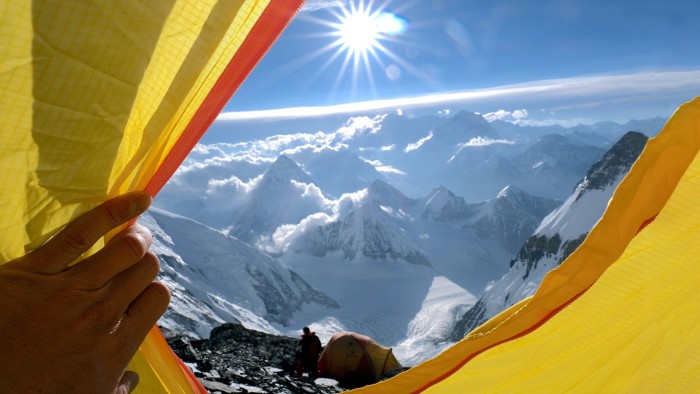Early this May, an airline pilot, two entrepreneurs and a government minister will wait for the call to mobilise. The British group’s gear will already be at Everest base camp alongside Lukas Furtenbach, an Austrian mountain guide. As soon as he declares that a weather window is about to open, his clients will dash to Heathrow for the next flights to Kathmandu.
They will then take a taxi straight to a health clinic. For 30 minutes, each adventurer will wear a mask attached to a ventilator for administering xenon, a rare noble gas more often used as an anaesthetic and a rocket propellant.
After inhaling a xenon blend formulated by a German doctor who first presented Furtenbach with the radical idea, the men will fly by helicopter to base camp. After no more than two hours to get ready and meet their half-dozen Sherpas, they will begin their ascent.
The xenon treatment is the key part of an audacious approach that Furtenbach thinks could transform commercial mountaineering. If he can pull off his plan, which he is revealing now after years of secret preparation, his clients hope to return to the UK just a week after they leave.
“I’m super-excited to see if we can leave home on a Monday morning, be on the summit of Everest on Thursday night, and make it home for Sunday lunch,” says Garth Miller, the pilot and leader of the group, which includes Alistair Carns, Britain’s veterans minister.
But the prospect of a seven-day Everest package, which Furtenbach says will cost around €150,000 (£124,000) per person — Miller’s group has paid an undisclosed introductory price — raises yet more ethical questions about the pull of the world’s highest peak, which traditionally requires up to 10 weeks to climb.
Since Everest entered the commercial tourism age in the 1990s, summit baggers have been accused of exploiting it in pursuit of bragging rights. Demand for speed has boomed alongside that for luxury camps equipped with saunas and en-suite bathrooms, as well as unlimited supplies of bottled oxygen and Sherpa muscle.
Meanwhile, growth at the lower end of the market, where packages have started for as little as $35,000 (£28,000) in recent years, has helped turn base camp into a polluting town a mile long. Photos of high-altitude conga lines on summit days have become as synonymous with the peak today as images of the pioneering mountaineers of yore.
In a modern era in which almost 400 paying clients now reach the summit each spring (assisted by the almost 500 guides and Sherpas who also get to the top), climbers and operators with social media accounts to burnish search for new “firsts”. Last May, Devon Lévesque, an American entrepreneur, briefly dropped his oxygen mask to claim the world’s first summit backflip.
Selling ever faster expeditions to cash-rich, time-poor adventurers who couldn’t dream of taking months or even weeks away from their busy lives has become another way for operators to stand out. Yet as last Tuesday’s earthquake on the Chinese side of the mountain showed, Everest is no playground.
Furtenbach tells me xenon will help make expeditions safer by cutting down his clients’ exposure to danger. But he’s also braced for a backlash in a community in which everyone draws their own ethical boundaries. After more than a century of attempts on the peak, is packaging Everest as a trip that could be over faster than the average beach holiday a step too far?
Furtenbach, who runs Furtenbach Adventures in Innsbruck, received an email from the doctor in 2019. Michael Fries is an anaesthetist at a hospital in Limburg an der Lahn in western Germany. He had heard about the guide’s already radical approach to the mountains that rise into the “death zone” above 8,000 metres, where oxygen levels are dangerously low.
Since 2006 Furtenbach, now 47, has been part of a small but growing niche of Everest guides who issue clients with hypoxic sleeping tents. For up to eight weeks before a trip, a machine extracts oxygen from sealed canopies over their beds. More recently, his clients have also begun breathing thinner air while working out in the gym, using masks or sealed chambers.
Simulating high-altitude conditions in advance, the theory goes, triggers the body’s natural response to hypoxia, or low oxygen levels, by telling the kidneys to make more erythropoietin, or EPO. The hormone, a synthetic version of which is banned in sport, boosts the production of red blood cells, increasing the body’s capacity to transport oxygen.
Mountaineers otherwise have to acclimatise by waiting for their kidneys to produce EPO on the mountain as a natural adaptation to an oxygen deficit. But this takes time, requiring rest and rotations, or temporary descents and repeated climbs. Get it wrong and hypoxia can cause symptoms ranging from headaches to death. Altitude sickness has killed about 15 per cent of the 335 people who have died on Everest.
By “pre-acclimatising”, and by optimising logistics and using advanced weather forecasting, Furtenbach has cut the time needed to rest and rotate. He already sells €103,900, three-week “flash” Everest trips. Meanwhile Alpenglow Expeditions, an American operator, used the strategy to enable Roxanne Vogel to make a 14-day Everest trip in 2019.
Fries told Furtenbach that xenon could unlock even faster ascents. The doctor knows all about the gas as an anaesthetic. But he says it has a separate effect at lower doses: boosting EPO production. “I was suggesting that a one-time xenon inhalation could be more effective than hypoxic tents and not as cumbersome,” he says. Furtenbach started planning a trial run.
A market for speed is growing beyond the world’s highest peaks. A spokesperson for the Antarctic operator White Desert tells me its “The Greatest Day” trips, which it introduced in 2020, sell out faster than ever. For just under $16,000, guests take a 10-hour flight from Cape Town for three hours on the ice, returning after a champagne picnic. A seven-day, $105,000 trip includes further flights to the South Pole itself.
Jimmy Carroll of tour operator Pelorus sees growing demand for shorter safaris, ski trips and volcano tours. Clients who want to see the Northern Lights now swoop into Norway for a night by private jet when the conditions look good. “The other big part of this trend is leaving things until the last minute,” Carroll adds. “Clients get a deal across the line, and they’re like, ‘Right, let’s go,’ because they can.”

Furtenbach, who had 40 Everest clients last year, says many people who contact him balk at the idea of devoting even three weeks to the mountain. Xenon seemed like a potentially powerful new tool. And while Fries accepts that the science on its use in mountaineering is thin, he says he has no safety concerns, given the wealth of studies about its use as an anaesthetic and the relatively low doses that Miller’s group will take. (Another anaesthetist I contact echoes this, while also pointing out that “unanticipated harm” is always possible with new approaches in extreme environments.)
Appointing himself as guinea pig, Furtenbach flew to Frankfurt for xenon treatment before an expedition to Aconcagua (almost 7,000 metres) in Argentina in January 2020. “I climbed a difficult route eight days from leaving Innsbruck, and had no problems on the summit,” he says. A simple fingertip device showed that his blood oxygen levels were higher than those of fully acclimatised local guides. “I was standing there, thinking, ‘OK, this really works.’ I was totally convinced.”
Furtenbach says he had similar successes with xenon in the following seasons, including on Everest. He also worked to improve the tight logistics that would be required. Covid delayed his plans. Then xenon became hugely expensive and almost impossible to source after the Russian invasion of Ukraine, which is the world’s largest supplier of noble gases. Fries tells me xenon for one climber now costs up to $5,000.
The stars then aligned for 2025, and Furtenbach began looking for his first seven-day clients. Miller, who’s 51, is no stranger to high mountains or hypoxic tents, which his group will use in addition to xenon. He first climbed in the Himalayas more than 20 years ago after joining the Gurkhas as a young British Army officer. He caught the speed bug in 2022 after a 21-day trip that included climbs of Everest and nearby Lhotse (8,516 metres).
He got in touch with Furtenbach and was “blown away” by his xenon plans. Furtenbach saw Miller as a good candidate. The pilot assembled a group of fellow veterans that also includes Kevin Godlington, 49, and Anthony Stazicker, 41. Like Carns, who is 44, the businessmen are fit and experienced climbers. The men, who are fundraising for Scotty’s Little Soldiers, a charity for bereaved military children, also have kids and busy jobs. “It’s speed that unlocks this dream for us,” Miller says.
While it will always be challenging, Everest is considered to be one of the easier high-altitude peaks. The main routes are lined with fixed ropes. In the absence of meaningful regulation in a profitable market, operators and their clients are left to read their own moral compasses.
Helicopters are increasingly used to bring climbers down from high camps, cutting short their descents. They are also being used by airborne sightseers, and as shuttles by climbers chasing speed records while summiting all 14 peaks that rise above 8,000 metres. In December, Nepal’s Civil Aviation Authority nixed plans by the national park in which Everest sits to restrict helicopter use after tour operators protested. “The tourism industry always prevails,” Furtenbach says.
Then there is the question of doping. Climbers have popped multiple pills over the years, including dexamethasone, a controversial steroid that can reduce brain swelling, one of the symptoms of altitude sickness. In 2014, the World Anti-Doping Agency added xenon to its banned list after reports of its use at the Sochi Winter Olympics.
Furtenbach, whose training rides and runs have been 10 per cent faster for days after xenon-fuelled climbs, was not aware of earlier attempts to use the gas on Everest. He says he has consulted medical lawyers to clarify in his own mind his response to any suggestion that his seven-day clients are doping. Ultimately, he tells me, “It’s not an organised sport, so there’s technically no doping in mountaineering.”
Again, it falls to individuals to decide where to draw the line. And the pull of a summit day on Everest almost always trumps any concerns about shortcuts — doping or otherwise. After all, all but five of the total 861 successful ascents last year were achieved with the purest drug of all: bottled oxygen, which simulates climbing at lower altitudes. And it is now being used at higher flow rates and from lower down the mountain, including even straight out of base camp.
Furtenbach’s great-uncle Oswald Oelz, an Austrian-Swiss mountaineer, was an expedition doctor on Reinhold Messner’s 1978 attempt to become the first person to climb Everest without bottled oxygen. Until then, it had been thought that you could sooner walk on the moon without oxygen than summit Everest. Oelz rejected prevailing wisdom and Messner made history. The Italian climber and explorer later described himself on the summit as “nothing more than a single narrow gasping lung”.
Oelz’s stories from the death zone later inspired Furtenbach and — perhaps — his suspicion of orthodoxy. Even while he was at school, the guide recalls infuriating teachers by questioning their methods: “I’d say, ‘If my solution is giving me the same result, why can’t I use it?’”
Miller is comfortable with the seven-day concept, but doesn’t recommend shortcuts before climbers endure — and enjoy — classic expeditions. “Don’t mistake this for a team that is fast-tracking Everest without having put in the hard yards,” he says. He won’t have time for a sauna at base camp even if he wanted one, meanwhile.
“You don’t have to suffer to show respect for the mountain, and doing it faster doesn’t make it easier,” adds Miller, whose group plans to take just three days to get from base camp to the summit, with no rotation, completing their descent on day four. “I would argue that the endeavour is greater. You can’t go higher, so going faster brings new and exciting challenges.”
Expeditions were getting faster long before hypoxic tents, which Furtenbach has issued to all his Everest clients since 2016. According to the Himalayan Database, which charts Everest expeditions, the average length of ascents, from base-camp arrival to summit (a good indicator of expedition length), has dropped steadily from around 60 days in the 1980s to 25 days in 2024.
The British mountaineer Sir Chris Bonington remembers taking 10 days just to trek to base camp in 1985, but he was only away from home for six weeks thanks to good weather, Sherpas and bottled oxygen. “Whereas back in 1961, when I climbed Nuptse, I was away for about 10 months,” he tells me. “But then I accompanied our gear on an ocean liner from Liverpool to Bombay and up overland.” Does the 90-year-old think a seven-day trip implies a lack of respect? “Everest doesn’t give a monkey’s toss about these little people crawling up and down it,” he says. “But I do regret what’s happening generally.”
The British guide Kenton Cool, who is going for his 19th Everest summit this spring, had heard chatter about xenon, and is sceptical of pre-acclimatisation. He thinks improvements in gear and weather forecasting, and a better understanding of what people are capable of with the right training and planning, have challenged older acclimatisation theories. He has done Everest in three weeks, and his private clients often do it in four, without pre-acclimatisation.
“I have huge respect for Lukas, but this is not something I advise my clients to subscribe to,” he says. “Maybe it’s a reflection on modern-day society, where we want everything yesterday, and nobody’s willing to wait.”
Alan Arnette, a chronicler of Everest who was part of a six-week trip in 2011, says the time spent trekking to base camp, enjoying Sherpa culture and multiple sunsets, is as memorable as summit day: “I think you can cut it to four weeks and maintain that, but one week is aggressive. You’re losing the spirit of expedition climbing.”
Adrian Ballinger, a British-born American mountain guide who founded Alpenglow Expeditions in 2004, tells me his “rapid” 36-day Everest trips started as a selfish act. “The old-school mountaineers who love sitting around drinking whisky and playing cards for weeks . . . that wasn’t me,” he says. He’s comfortable with his own approach, but sees no limit to how easy Everest can be made. “Someone will take this to the point where it essentially becomes like space tourism. You’ll wear a spacesuit, with oxygen from when you arrive, and then anyone can climb Everest in four days.”
Furtenbach can’t control flight delays or other potential snags, but he’s confident his clients will succeed. He’s also braced for criticism. When Swiss TV recently followed his current “flash” expedition, “there was almost a shitstorm. People were saying, ‘This is destroying the experience, it’s the end of the adventure.’” He says German-speaking countries in particular cleave to the Messner ideal. Paraphrasing Everest’s purist-in-chief, who’s 80, Furtenbach says Messner believes that “alpinism is only real if you can die . . . But for me and my clients, dying is not an option.”
Furtenbach, who has two young children, says well-managed trips get safer with every day out of the death zone or the Khumbu Icefall above base camp, which climbers traditionally navigate several times during rotations. As well as bottled oxygen, he says Miller’s group will carry pure oxygen in case anyone falls sick.
“These are life-saving investments,” says Miller, who also has a young son and daughter. But it’s clear that he and Furtenbach, who operates in a highly competitive market, are driven primarily by a motive that has always drawn people to Everest: the desire to be first. “Things are changing in high-altitude mountaineering and if we don’t get involved at the forefront, someone else will,” adds Miller, who in a couple of weeks will ramp up his training, dig out his hypoxic tent, and hope that xenon prices remain stable.
Find out about our latest stories first — follow FT Weekend on Instagram and X, and sign up to receive the FT Weekend newsletter every Saturday morning
Read the full article here




